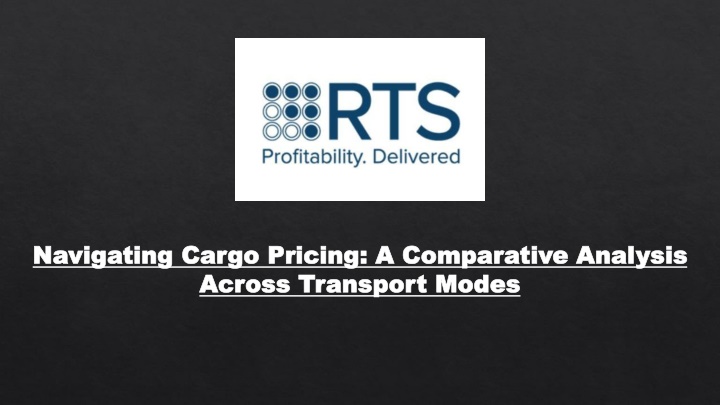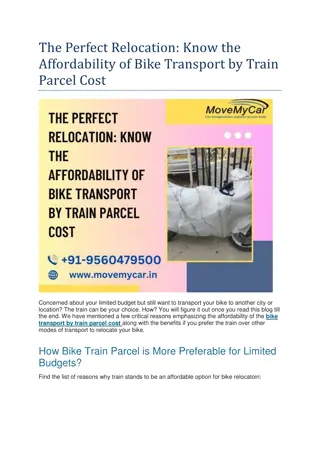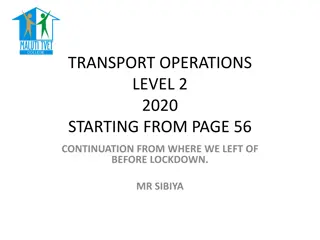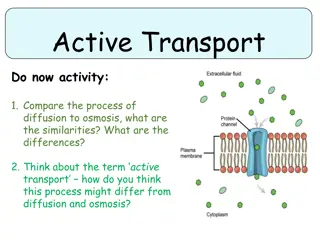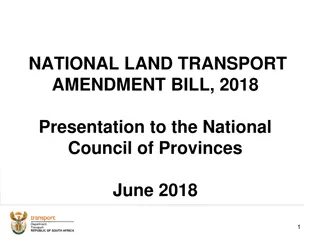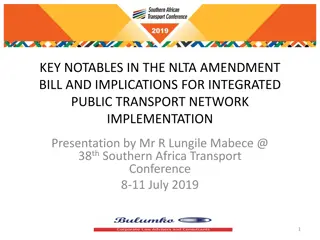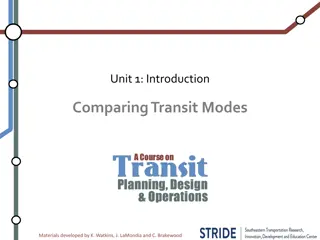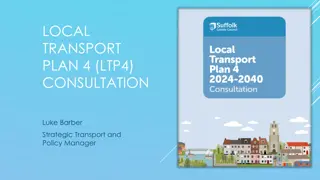A Comparative Analysis Across Transport Modes
In the dynamic landscape of global trade and logistics, the efficient movement of goods is paramount. Central to this process is cargo pricing, a critical determinant that significantly impacts supply chain decisions and costs. As businesses strive to optimize their logistics operations, understanding the nuances of cargo pricing across different transport modes becomes essential. In this comparative analysis, we delve into the intricacies of cargo pricing across various transportation methods, shedding light on their respective advantages, challenges, and implications.n
Download Presentation

Please find below an Image/Link to download the presentation.
The content on the website is provided AS IS for your information and personal use only. It may not be sold, licensed, or shared on other websites without obtaining consent from the author.If you encounter any issues during the download, it is possible that the publisher has removed the file from their server.
You are allowed to download the files provided on this website for personal or commercial use, subject to the condition that they are used lawfully. All files are the property of their respective owners.
The content on the website is provided AS IS for your information and personal use only. It may not be sold, licensed, or shared on other websites without obtaining consent from the author.
E N D
Presentation Transcript
Navigating Cargo Pricing: A Comparative Analysis Navigating Cargo Pricing: A Comparative Analysis Across Transport Modes Across Transport Modes
In the dynamic landscape of global trade and logistics, the efficient movement of goods is paramount. Central to this process is cargo pricing, a critical determinant that significantly impacts supply chain decisions and costs. As businesses strive to optimize their logistics operations, understanding the nuances of cargo pricing across different transport modes becomes essential. In this comparative analysis, we delve into the intricacies of cargo pricing across various transportation methods, shedding light on their respective advantages, challenges, and implications. Air Air Freight: Freight: Air freight stands out for its unparalleled speed and reliability, making it the preferred choice for time-sensitive shipments. However, this expediency comes at a premium, with air cargo rates typically being the highest among transport modes. Factors such as fuel costs, capacity constraints, and airport charges contribute to the cost structure of air freight. Moreover, fluctuating demand and seasonality further influence dynamic pricing, leading to price volatility.
Ocean Ocean Freight Freight: In contrast, ocean freight offers a cost-effective solution for transporting large volumes of cargo over long distances. Containerization has revolutionized maritime shipping, enabling economies of scale and enhanced efficiency. Ocean freight rates are influenced by factors like vessel capacity, fuel prices, port charges, and trade lane demand. While slower transit times may be a drawback, savvy shippers leverage ocean freight for its cost efficiency, especially for non-time-sensitive goods. Road Road Freight: Freight: Road freight provides flexibility and door-to-door connectivity, making it a vital component of the logistics network, particularly for regional and domestic transport. Pricing in road freight is influenced by factors such as fuel costs, vehicle type, distance traveled, tolls, and driver wages. While road transport offers speed and convenience for short to medium-haul shipments, it may face challenges such as congestion, regulatory compliance, and infrastructure limitations. Rail Rail Freight: Freight: Rail freight offers a balance between cost efficiency and reliability, particularly for intermodal transportation. Rail transport is well-suited for long-haul shipments, offering competitive rates compared to air and road transport. Pricing in rail freight is influenced by factors such as distance, equipment type, fuel costs, rail infrastructure fees, and terminal handling charges. Additionally, rail freight is often favored for its environmental sustainability, contributing to a greener supply chain.
Intermodal Intermodal Solutions: provides a holistic approach to cargo movement. By leveraging the strengths of each mode, intermodal solutions offer cost optimization, flexibility, and reliability. Pricing in intermodal transport is influenced by factors such as route efficiency, mode selection, equipment availability, and terminal handling fees. Shippers benefit from integrated pricing models and streamlined operations, enhancing overall supply chain efficiency. Solutions: Intermodal transportation, combining multiple modes of transport seamlessly, Conclusion: Conclusion: In conclusion, cargo pricing across different transport modes is a multifaceted aspect of logistics management, shaped by various economic, operational, and market factors. Each mode offers distinct advantages and trade-offs, catering to specific shipment requirements and business objectives. By conducting a comparative analysis of cargo pricing, businesses can make informed decisions, optimize cost structures, and enhance supply chain resilience. Ultimately, a strategic approach to cargo pricing ensures efficient and cost-effective movement of goods, driving competitiveness and success in the global marketplace.
THANK YOU THANK YOU
